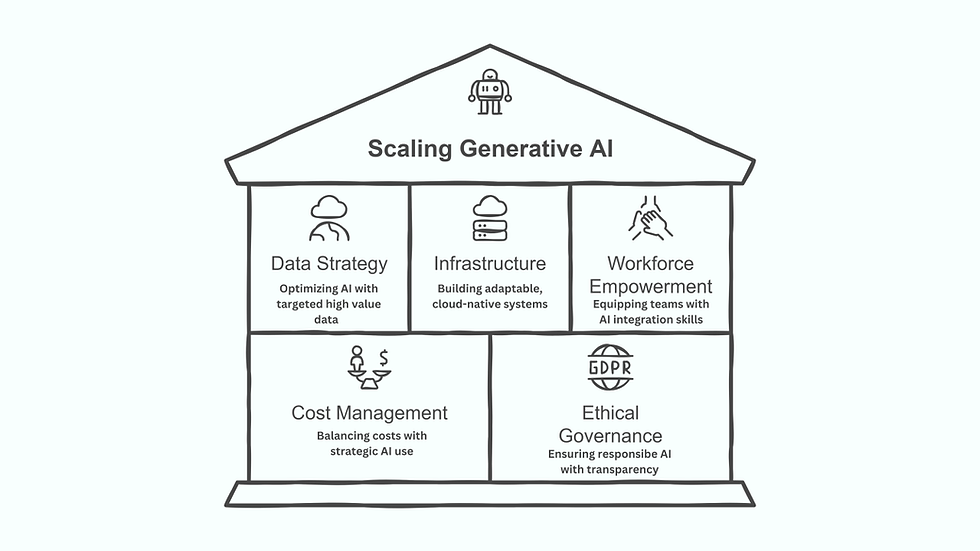The Rhythm of Innovation: Aligning AI Strategies Across the Organization
- Chandrayee Sengupta
- Jan 3
- 3 min read

The advent of AI is revolutionizing software development and, consequently, reshaping the operational landscape of companies embracing this technology. This evolution is prompting a new generation of companies to emerge, transforming every company into a software company at its core. The transition to an AI-centric organization necessitates a comprehensive reevaluation of how businesses operate, engage with customers, empower employees, and define their products. Here’s a guide on how organizations can effectively navigate this transformative journey.
AI-Driven Organizations: A New Business Paradigm
In the digital age, virtually every company relies heavily on software, making them "software companies" in a sense. As AI-powered software emerges, it fosters the development of a new type of organization—the AI-driven company. This transition, however, necessitates a fundamental change in organizational thinking.
Navigating the AI Transformation Journey
The journey towards becoming an AI-driven organization is not a one-time implementation but an ongoing process. It requires a strategic approach where each tactical use case contributes to a broader organizational transformation. Similar to performing a symphony, every part of the organization plays a critical role in creating harmonious AI integration.
Starting with a Strong Technical Core: The Composer and Core Melody
The initial phase often involves establishing a solid technical foundation within the organization. This is akin to the composer creating the core melody of a symphony, representing the core technical departments like IT and Development. Building this core competency is important as it sets the tone and provides the main theme upon which the entire AI transformation is built. This foundational work enables organizations to differentiate themselves in the rapidly evolving business landscape.
From Use Cases to Organizational Change: Harmonies and Instrumentation
While a strong technical foundation is essential, practical AI use cases are vital to demonstrate value and gain momentum. This stage parallels adding harmonies and instrumentation to the core melody. Business units across the organization contribute their unique perspectives and needs, much like different instruments—strings, brass, woodwinds, and percussion—adding depth and complexity to the symphony. Collaborating with business leaders who are early adopters of AI can be immensely beneficial. Real-world AI projects serve a dual purpose: they address specific business challenges and help attract and retain AI talent, a key roadblock for many organizations.
Expanding AI Across the Organization: Orchestra Members Performing Together
AI implementation is not confined to technical departments; it should permeate throughout the organization. This expansion is similar to the orchestra members—employees at all levels, from frontline staff to back-office operations—coming together to perform the symphony. Their collective effort brings the composition to life, interpreting the AI strategies and delivering a cohesive performance across the organization. The aim is to integrate AI into the fabric of the organization, making it central to decision-making and operations rather than an isolated component.
Leadership as the Conductor
The leadership team acts as the conductor, guiding the tempo, dynamics, and expression of the AI transformation. They ensure that every department is aligned and working together harmoniously toward the strategic vision. Leadership steers the AI transformation journey, fostering collaboration across departments and encouraging widespread adoption.
Strategic Selection of Applications for AI Transformation
Organizations need to carefully select the applications that will benefit most from AI integration.
Identifying Candidate Applications
The process begins with a thorough review of the existing software portfolio, focusing on well-documented and business-critical systems. These applications are categorized into Systems of Record (e.g., ERP, CRM, SCM) and Systems of Engagement (interfaces for customer and employee interaction).
Systems of Engagement, which are frequently a mix of in-house, outsourced, or off-the-shelf solutions, are often the prime candidates for AI transformation.
Key Selection Criteria
Choosing the right applications requires careful consideration of several factors:
Relevance: How crucial is the application to core business operations?
Control: Does the organization have sufficient control over the application's functionality and data?
Impact: What is the anticipated positive impact of integrating AI, and how will this impact be measured?
Resources: What are the estimated time and effort required for the transformation, and are these resources available?
Differentiation: Can AI integration create a sustainable competitive advantage in the market?
Network Effects: Will the application's AI enhancement generate valuable data that can fuel further innovation and create a positive feedback loop?
Finally,
the successful integration of AI demands a strategic roadmap that encompasses not just technological advancement but also organizational adaptation. By carefully evaluating existing systems, identifying suitable applications for AI transformation, and fostering an AI-driven culture, organizations can harness the transformative power of AI to redefine their operations, engage with customers in novel ways, and unlock new avenues for growth and innovation. The choices you make today will have lasting impacts.
Today, how is each department in your organization leveraging AI to not only improve their functions but also contribute to the organization's overarching goals?
Please share your thoughts below.



Comments